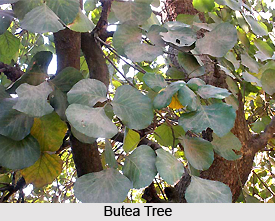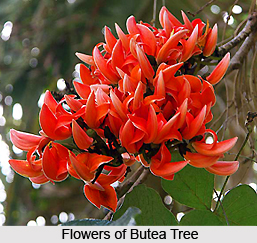 Butea, also known as "flame of die forest", is a well-known tree of India. The scarlet and orange flowers of the tree renders its name perfect. Butea is a medium-sized tree, with compound leaves. The leaves shed in winter and flowers blossom in February-March in small but thick bunches, mostly on leafless branches, and the tree appears to be ablaze. The fruits are flat pods, with a single seed in every fruit.
Butea, also known as "flame of die forest", is a well-known tree of India. The scarlet and orange flowers of the tree renders its name perfect. Butea is a medium-sized tree, with compound leaves. The leaves shed in winter and flowers blossom in February-March in small but thick bunches, mostly on leafless branches, and the tree appears to be ablaze. The fruits are flat pods, with a single seed in every fruit.
This herb is native to India. The trade name `butea`, is based on the scientific name of the plant. The tree is found predominantly in the mixed or dry deciduous forests of Central and Western India.
The red-coloured gum, called `Bengal kino` or butea gum, found from the tree, is rich in gallic and tannic acids. The seeds have a yellow fixed oil, called moodooga oil or kino-tree oil, tiny quantities of a resin and enormous quantities of a water-soluble albuminoid. Fresh seeds contain proteolytic and lipolytic enzymes. The flowers contain glucosides, butrin, butin and neteroside. A number of fatty acids have been separated from the oil.
Methods of usage
Butea, utilised separately or mixed with other ingredients, brings cure to almost every common disorder under the every day sun.
Healing Power and Curative Properties of butea
The butea gum, the seeds and leaves of the tree have curative properties. The leaves of the tree act as revitaliser and aphrodisiac. They are useful in checking secretion or haemorrhage.
Diarrhoea and Dysentery cured by butea
The gum of the tree is useful in the curing of diarrhoea and dysentery. Its process is however gentle, especially suited to children and women of fragile tendency. It is given in dosages of 3 decigrams to 2 grams, with a few decigrams of aromatics. The leaves can be chewed orally during the illness. Extract or decoction of the gum as a rectal enema will produce immediate respite. Fresh juice of the leaves is also helpful in these diseases.
 Intestinal Worms eliminated by butea
Intestinal Worms eliminated by butea
The seeds are dispensed internally, both in the form of powder or made into a paste with honey as an anthelmintic to obliterate intestinal worms. They are especially useful in the treatment of roundworms and tapeworms. Latest experiments have corroborated their effectiveness in eradicating round worms. Approximately 1 gram of the seeds blended with honey can be given thrice daily for 3 days to treat intestinal worms. On the fourth day, a dosage of castor oil may be dispensed to empty the bowels.
Skin Disorders healed by butea
The seeds are helpful in treating specific skin disorders. The seeds, mashed and blended with lemon juice, can be smudged on dhobi`s itch-an eczema-type of skin irritation, characterised by itching. They can also be massaged with satisfying results on ringworms. A hot poultice of the leaves can be implemented to heal boils, pimples, tumorous piles, ulcers and inflammations. The powered seeds can be used for obliterating maggots in injuries and sores.
Diabetes cured by butea
The leaves of the tree are very helpful in curing diabetes. They cut down blood sugar level and are useful in glycosuria- i.e., the presence of a huge quantity of glucose in urine.
Leucorrhea healed by butea
The leaves are also of use in the treatment of leucorrhoea. Decoction or an extract of leaves should be used as a vaginal douche for this intention.
Sore Throat cured by butea
The leaves are useful in blocked and septic throat. A decoction of the leaves achieved by boiling them in water, should be used as a mouth-wash in the cure of this ailment.
Retention of Urine healed by butea
The leaves are useful in treating the problem of withholding of urine. The pubic area should be fomented with the leaves in such turmoil.











